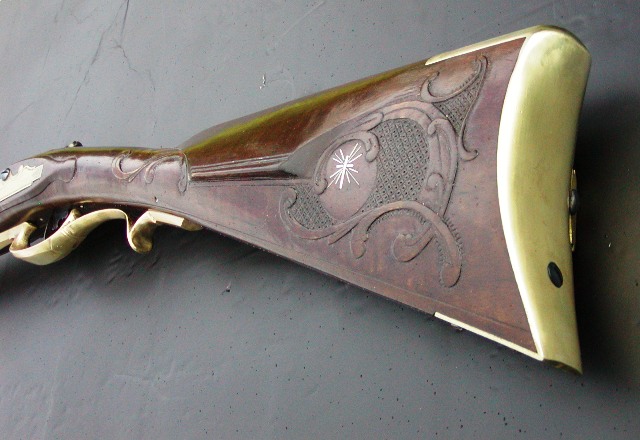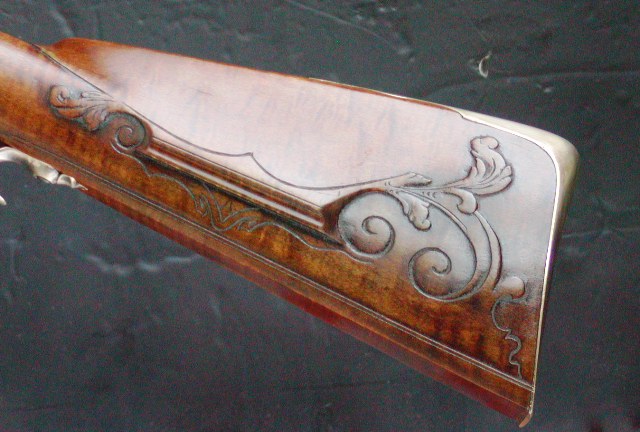I was curious if any of our master builders here use a "golden mean" for design of their carving and/or a template to assist.
If so, I have searched and searched the Inet for such a template and have yet to find one. All I have found is a french curve set.
Does any one have a source for said template?
I don't know of a commercial template that one can use to draw a "golden spiral", but you can draw your own guide that you can trace or use for practice to train your eyes and hands to free-hand draw scrolls.
The cover on Barry Bohnet's booklet mentioned before actually shows the construction aid.
If you take a piece of paper and draw a large rectangle with the long side being 5 units and the short side being 3 units you have something close to the "Golden Rectangle".
I say close because the Golden Mean is a proportion of 1 to 1.618. If you divide 5 by 3, you get the ratio of 1.666... This may be like Dave Person saying, "I use the golden mean rule as a standard to violate constantly." It's close but not exact. But it is close enough for our gun work.
Now if you take your large 3x5 rectangle and draw a line across it to form a 3x3 square in the top segment, you will have a smaller (almost) Golden Rectangle in the lower segment.
Now draw a vertical line in the lower rectangle that will form a square on the left and another smaller Golden rectangle on the right.
Again draw a horizontal line across this newest rectangle to form a square at the bottom and a rectangle at the top.
Divide this latest rectangle into a square on the right and another small rectangle on the left.
Hopefully, you are seeing the pattern now where you can divide this newest small rectangle into a square and rectangle, each one getting progressively smaller.
In the illustration above, we have six squares that get progressively smaller.
Starting with the largest square, take a draftsman's compass with the point in the lower right corner of the square and extend the lead until it touches the other side of the square. Using the compass in this position, draw an arc from one adjacent corner to the other as in the illustration.
Go to the next smallest square with the compass point at the upper right corner and extend it to reach an adjacent corner and draw another arc that meets with the lower end of the first arc you drew.
Repeat this process with each succeeding smaller square using the inside corner of the square to locate the point of the compass and one of the adjacent corners for the radius of the arc.
With each arc touching the next, you will form a spiral that is close to the Golden Spiral.
Practice this enough or use it as a visual guide and you can learn to free-hand spirals good enough to form the basis for your carving. They don't have to be perfect Golden Spirals to still be pleasing to the eye. But you do want smooth curves that easily flow for the eye to follow.
Another useful guide in your design development is the the Golden Ellipse. Again, we can approximate it with an ellipse that is 5 units along in major axis and 3 units for its minor axis. Use a series of these ellipses to outline the major elements of your design such as C-scrolls and volutes and acanthus leaves.
The Rococo design that was dominate in the 18th century developed from the Baroque design of the 17th century, but exhibited asymmetrical elements rather than the symmetrical designs common in the Baroque period.
In colonial gunstock carving that means it is ok to have one side of the C-scroll larger than the other (or one volute larger than the other volute). For the carving behind the cheekpiece, the part of the C-scroll or volute closest to the butt plate is usually larger than the one closest to the cheekpiece. This is pleasing to the eye because the butt stock is triangular shaped and the carving takes up more space. It is also ok to have only half of a C-scroll in certain areas of a the design such as the acanthus leaf curving up and forward in the illustration immediately above.
Lancaster gunsmiths developed a double C-scroll design that has the upper C-scroll kind of compressed with the minor axis shorter the the Golden Mean proportion would suggest. Jacob Dickert is well known for this design, but numerous other Lancaster gun makers used it.
This is probably not the best example but the only example of a Dickert rifle I have handy.
I think this non-proportional upper C-scroll works because it suggests depth or distance like the perspective lines that merge at the horizon. It helps to create an optical illusion.
In building and decorating American longrifles, the Golden Mean proportion is not a dogma or a hard-n-fast rule.
I doubt that many of the old masters were even aware of it. But they still subconsciously incorporated many aspects of it because they made rifles that were pleasing to their eye.
Today, it can be a useful guide to inexperience longrifle gunmakers in a number of ways well beyond carving design. It can well be worth investigating and becoming more familiar with.









